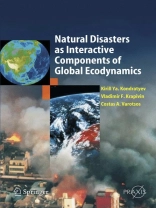Large-scale natural catastrophes are environmental phenomena. Numerous studies in recent years have concluded that the frequency of occurrence of such natural disasters have been incereasing. leading to an enhanced risk of very considerable human and economic losses and the widespread destruction and pollution of habitats, settlements and infrastructure. In 2001 over 650 natural disasters happened around the globe with economic losses exceeding $35 billion. 2004 ended with the South East Asian tsunami on 26th December with its huge toll on life and local economics and this demonstrated that the efffects of such disasters are most keenly felt in poorer or developing regions.
The problem of natural disaster prediction and the implementation of environmental monitoring systems to receive, store and process the information necessary for solutions of specific problems in this area , have been analysed by the three authors of this book, all of whom are internationally respected experts in this field.
Table of Content
Statistics of natural disasters.- Natural disasters and the survivability of ecological systems.- Biocomplexity as a predictor of natural disasters.- Natural disasters and humankind.- The monitoring of natural disasters.- Prediction of natural disasters.- The natural catastrophe in the Aral Sea region.- Natural disasters as components of global ecodynamics.- Interactivity of climate and natural disasters.












